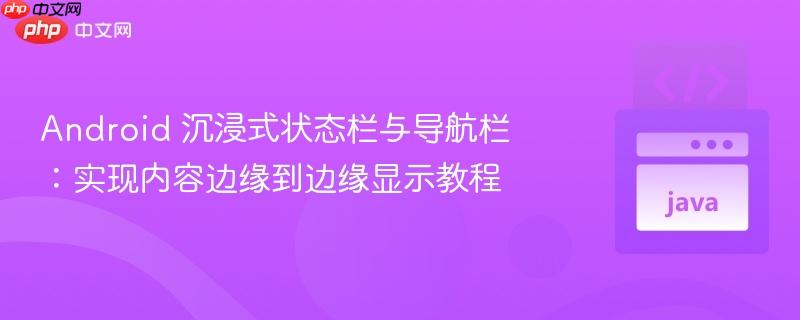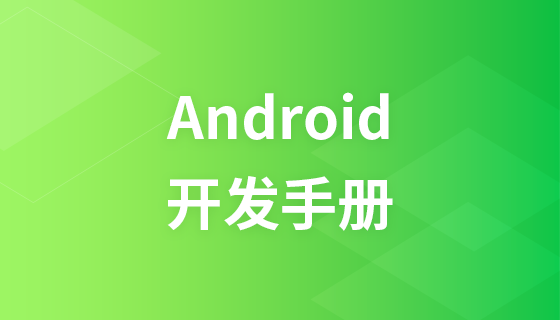
在 android 应用开发中,状态栏(status bar)和导航栏(navigation bar)是系统提供的ui元素,它们通常会占据屏幕顶部和底部的一部分区域。默认情况下,android 系统会为这些系统栏创建“内边距”(insets),确保应用内容不会被它们遮挡。这种设计虽然保证了内容可见性,但限制了应用界面的视觉延伸感。
沉浸式体验的目标是让应用内容能够延伸到系统栏的下方,实现内容“边缘到边缘”(Edge-to-Edge)的显示效果。这意味着状态栏和导航栏可以是透明的,应用内容可以在这些区域绘制,从而提供更广阔、更具沉浸感的视觉体验。
要实现透明的状态栏和导航栏,并使内容延伸至屏幕边缘,需要进行以下关键配置:
在应用的 themes.xml 文件中,为你的应用主题设置透明的 statusBarColor 和 navigationBarColor。
<!-- res/values/themes.xml 或 res/values-v21/themes.xml (如果需要兼容旧版本) -->
<resources>
<style name="AppTheme" parent="Theme.MaterialComponents.DayNight.NoActionBar">
<!-- 设置状态栏颜色为透明 -->
<item name="android:statusBarColor">@android:color/transparent</item>
<!-- 设置导航栏颜色为透明 -->
<item name="android:navigationBarColor">@android:color/transparent</item>
<!-- 可选:禁用对比度强制,以确保完全透明,但需注意内容可见性 -->
<!-- 对于某些Android版本或特定设备,这些属性可能需要设置为false以确保完全透明 -->
<!-- <item name="android:enforceStatusBarContrast">false</item> -->
<!-- <item name="android:enforceNavigationBarContrast">false</item> -->
</style>
</resources>注意事项:
在 Activity 的 onCreate 方法中,使用 WindowCompat API 来指示系统不要为内容视图添加系统窗口内边距。这是实现内容延伸到系统栏下方的关键一步。
import android.os.Bundle;
import androidx.appcompat.app.AppCompatActivity;
import androidx.core.view.WindowCompat; // 确保导入 androidx.core.view.WindowCompat
import android.view.Window;
public class MainActivity extends AppCompatActivity {
@Override
protected void onCreate(Bundle savedInstanceState) {
super.onCreate(savedInstanceState);
// 获取当前窗口
Window window = getWindow();
// 关键一步:告诉系统不要为内容视图添加系统窗口内边距
// 这将允许应用内容绘制到状态栏和导航栏的下方
WindowCompat.setDecorFitsSystemWindows(window, false);
setContentView(R.layout.activity_main);
// 如果你的布局中有需要响应系统内边距的特定视图(例如,避免内容被导航栏遮挡),
// 可以使用 ViewCompat.setOnApplyWindowInsetsListener 进行更精细的控制。
// 示例:为根布局设置内边距监听器
// ViewCompat.setOnApplyWindowInsetsListener(findViewById(R.id.root_layout), (v, insets) -> {
// // 获取系统栏的内边距
// Insets systemBars = insets.getInsets(WindowInsetsCompat.Type.systemBars());
// // 根据需要调整视图的 padding 或 margin,例如,为RecyclerView添加底部padding
// // v.setPadding(systemBars.left, systemBars.top, systemBars.right, systemBars.bottom);
// // 返回insets,以便它们可以被分发给子视图
// return insets;
// });
}
}即使你按照上述步骤配置了主题和 WindowCompat.setDecorFitsSystemWindows(window, false),有时内容仍然无法延伸到屏幕边缘。这通常是由于布局文件中的 android:fitsSystemWindows="true" 属性导致的。
android:fitsSystemWindows="true" 属性是告诉 Android 系统为该视图及其子视图应用系统窗口内边距。如果你的根布局或其某个父布局设置了此属性,它将覆盖 WindowCompat.setDecorFitsSystemWindows(false) 的效果,导致内容仍然被系统栏推开。
解决方案:
检查你的布局文件,确保你的根布局(或任何你希望延伸到屏幕边缘的视图)没有设置 android:fitsSystemWindows="true"。通常,你应该将其设置为 false 或直接移除(默认值为 false)。
示例 XML 布局:
<!-- activity_main.xml -->
<androidx.constraintlayout.widget.ConstraintLayout
xmlns:android="http://schemas.android.com/apk/res/android"
xmlns:app="http://schemas.android.com/apk/res-auto"
xmlns:tools="http://schemas.android.com/tools"
android:id="@+id/root_layout"
android:layout_width="match_parent"
android:layout_height="match_parent"
android:fitsSystemWindows="false" > <!-- 关键:确保此属性为 false 或不设置 -->
<!-- 你的应用内容将在此处绘制,并可以延伸到系统栏下方 -->
<ImageView
android:layout_width="0dp"
android:layout_height="0dp"
android:scaleType="centerCrop"
android:src="@drawable/background_image"
app:layout_constraintTop_toTopOf="parent"
app:layout_constraintBottom_toBottomOf="parent"
app:layout_constraintStart_toStartOf="parent"
app:layout_constraintEnd_toEndOf="parent" />
<TextView
android:layout_width="wrap_content"
android:layout_height="wrap_content"
android:text="内容已延伸至屏幕边缘"
android:textColor="@android:color/white"
android:textSize="24sp"
app:layout_constraintTop_toTopOf="parent"
app:layout_constraintStart_toStartOf="parent"
app:layout_constraintEnd_toEndOf="parent"
app:layout_constraintBottom_toBottomOf="parent" />
</androidx.constraintlayout.widget.ConstraintLayout>通过以上步骤和注意事项,你可以有效地在 Android 应用中实现美观且功能完善的沉浸式状态栏和导航栏效果,提升用户体验。
以上就是Android 沉浸式状态栏与导航栏:实现内容边缘到边缘显示教程的详细内容,更多请关注php中文网其它相关文章!

每个人都需要一台速度更快、更稳定的 PC。随着时间的推移,垃圾文件、旧注册表数据和不必要的后台进程会占用资源并降低性能。幸运的是,许多工具可以让 Windows 保持平稳运行。




Copyright 2014-2025 https://www.php.cn/ All Rights Reserved | php.cn | 湘ICP备2023035733号